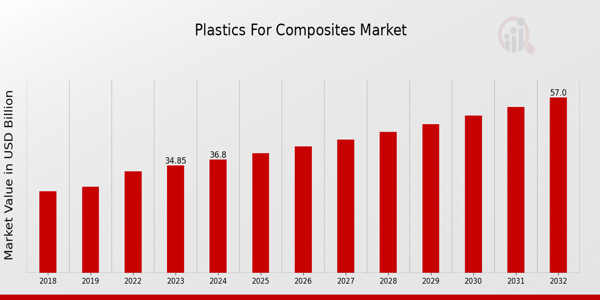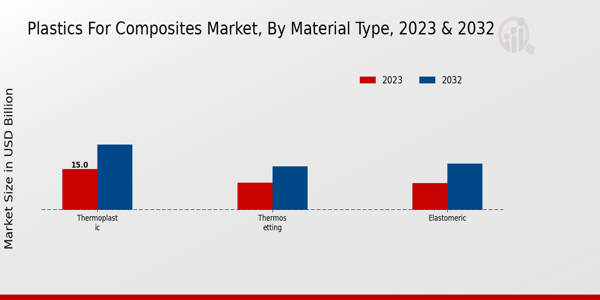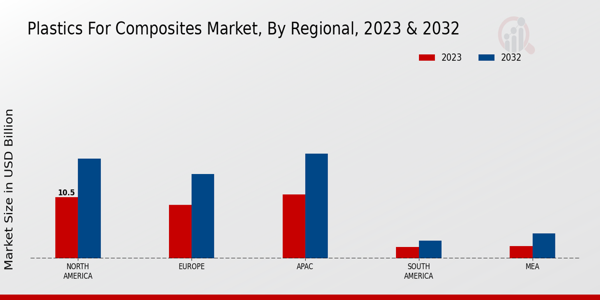Global Plastics for Composites Market Overview
The Plastics for Composites Market Size was estimated at 38.87(USD Billion) in 2024. The Plastics for Composites Industry is expected to grow from 41.06(USD Billion) in 2025 to 67.17(USD Billion) by 2034. The Plastics for Composites Market CAGR (growth rate) is expected to be around 5.60% during the forecast period (2025 - 2034).
Key Plastics for Composites Market Trends Highlighted
The Plastics for Composites Market is actively on the rise owing to the increased demand for lightweight, but more superior materials in various industries. There is a noteworthy emphasis on the automotive industry to create new composite materials that will help in building vehicles that are more fuel-efficient with lower emissions. In addition, the construction industry is also switching to using plastic composites materials to enhance the durability and sustainability of the structures. The industry is driven forwards by the notching increase in environmental concerns and that there is a need for energy saving solutions.
Other factors including technological developments in processing technologies and growing acceptance of composites as an alternative to traditional materials also contribute to the growth of this market.
There is quite a number of opportunities in the Plastics for Composites Market especially in countries that are developing, and where there are growing economies, there is an increasing activity in construction and manufacturing. There is a clear trend towards sustainable and bio-based composites which will open up avenues for companies to come up with new ideas and differentiate their products. Greater demand for new advanced composite materials is anticipated as industries seek materials that comply with regulatory laws and environmental limits.
There are also new applications in the aerospace industry and the renewable energy sector that provide attractive opportunities for market players as they seek to take advantage of the market shift to better materials.
There is a notable trend whereby manufacturers are beginning to pay attention to more environmentally friendly practices, such as recycling and the circular economy concept. Some novelty forms such as bioplastics and thermoplastic composites are on the rise. More so, the integration of digitalisation and automisation in the production processes is enhancing efficiency and reducing unnecessary wastes which meets market needs for cheaper alternatives. In conclusion, the Plastics for Composites Market is on the growth path, which is quite encouraging and is likely to be facilitated by new trends of consumers, technological evolution and globalisation of the green agenda.

Source: Primary Research, Secondary Research, Market Research Future Database and Analyst Review
Plastics for Composites Market Drivers
Increasing Demand for Lightweight Materials
The Plastics for Composites Market Industry is experiencing significant growth driven by the increasing demand for lightweight materials across various industries. As manufacturers strive to enhance fuel efficiency and reduce emissions, particularly in the automotive and aerospace sectors, the use of plastics for composites has become more prevalent. Lightweight materials not only contribute to improved performance but also help in lowering overall energy consumption.The push to develop sustainable and environmentally friendly products has further propelled the adoption of plastics for composites as they often offer a favorable weight-to-strength ratio compared to traditional materials.
Furthermore, the ongoing trend towards automation and advanced manufacturing technologies in various sectors is leading to innovative applications of plastics for composites, facilitating their integration into mixed-material constructions.This trend is likely to augment the market growth as companies seek to leverage the competitive advantages offered by lightweight composites. As environmental regulations become stricter and sustainability becomes a core focus, the Plastics for Composites Market Industry is poised for accelerated growth, providing opportunities for manufacturers to develop advanced solutions to meet market demands.
Rising Adoption in Construction and Infrastructure
The Plastics for Composites Market Industry is witnessing a surge in adoption within the construction and infrastructure sectors. The demand for durable, corrosion-resistant, and lightweight materials is driving the integration of plastics for composites into building applications. These materials help in enhancing the structural efficiency of buildings and infrastructure projects while also providing long-term cost benefits through reduced maintenance and lifecycle costs.Additionally, the trend towards modular construction and prefabricated building components is bolstering the use of plastics for composites, leading to faster construction timelines and improved project outcomes.
The shift towards more sustainable and energy-efficient building practices is further aligning with the benefits offered by composite materials, thus fueling market growth.
Technological Advancements in Material Science
Technological advancements in material science are serving as a catalyst for the growth of the Plastics for Composites Market Industry. Innovations such as enhanced resin formulations, improved composite manufacturing techniques, and advanced processing methods are enabling the development of high-performance composites with superior properties.
These advancements facilitate the creation of composites that are lighter, stronger, and more durable, making them ideal for a diverse range of applications in industries such as automotive, aerospace, and consumer goods.As new technologies continue to emerge, they open up possibilities for the integration of plastics for composites into previously untapped sectors, further broadening the scope of market opportunities.
Plastics for Composites Market Segment Insights
Plastics for Composites Market Material Type Insights
The Plastics for Composites Market, focusing on the Material Type segment, is characterized by its diverse composition, mainly consisting of Thermoplastic, Thermosetting, and Elastomeric materials. The market shows a strong inclination towards Thermoplastics, which are projected to hold a significant share, valued at 15.0 USD Billion in 2023 and expected to grow to 24.0 USD Billion by 2032. This material type influences multiple industries due to its recyclability and versatility in applications, making it an essential choice for manufacturers striving for sustainability and efficiency.
Thermosetting materials, although slightly less dominant, still command a notable segment in the market, with a valuation of 10.0 USD Billion in 2023, increasing to 16.0 USD Billion in 2032. These materials offer unique properties such as high thermal stability and superior strength, which are critical in demanding applications ranging from automotive to aerospace. Moreover, the Elastomeric segment, representing a valuation of 9.85 USD Billion in 2023 and expected to rise to 17.0 USD Billion in 2032, is equally significant.
The distinct flexibility and durability of elastomeric materials cater to specialized applications, particularly in industries like consumer goods and medical devices.Overall, the Plastics for Composites Market data highlights the growing preference for Thermoplastic materials, attributed to their ability to balance performance and environmental concerns. The market trends indicate a shift towards more sustainable and efficient production processes, with an increasing demand for materials that align with stricter environmental regulations. This shift is, therefore, likely to act as a growth driver within the Thermoplastic segment, potentially influencing the broader market growth trajectory.
However, challenges such as raw material costs and competition from alternative materials could impact profitability and pricing strategies across all material types. Nonetheless, opportunities for innovation in polymer chemistry and advanced manufacturing processes present a promising landscape for the Plastics for Composites Market industry, fostering further development and segmentation within Thermoplastic, Thermosetting, and Elastomeric materials. The expected market growth reflects the crucial role these materials play in modern applications, with ongoing research and development enhancing their functionalities and broadening their application scope significantly.

Source: Primary Research, Secondary Research, Market Research Future Database and Analyst Review
Plastics for Composites Market Application Insights
The application segment of the Plastics for Composites Market has showcased significant prominence, with a projected market value reaching 34.85 USD Billion in 2023. This segment is primarily driven by industries demanding lightweight yet durable materials, and it covers critical areas such as Aerospace, Automotive, Construction, and Electrical and Electronics. The aerospace sector greatly benefits from the use of high-performance composites, which lead to enhanced fuel efficiency and reduced weight in aircraft structures.
In the Automotive industry, the shift towards electric vehicles has spurred the adoption of composite materials, known for their strength and lightweight properties.The Construction sector also plays a crucial role, utilizing composites to improve structural integrity and longevity, while the Electrical and Electronics segment requires materials that provide excellent insulation and thermal properties. As the market continues to evolve, growth drivers include the rise in demand for eco-friendly materials and innovations in manufacturing processes, although challenges such as raw material costs and recycling issues persist.
Overall, the Plastics for Composites Market revenue is set to benefit as these applications expand, presenting opportunities for development and sustainability in various industries.
Plastics for Composites Market End Use Insights
The Plastics for Composites Market, valued at 34.85 Billion USD in 2023, is experiencing robust growth driven by its diverse end-use applications. The manufacturing sector prominently utilizes plastics for composites due to their lightweight properties and strength, leading to enhanced productivity and efficiency in production processes. The retail sector also significantly contributes, as retailers increasingly use composite materials for packaging innovations, which cater to sustainability demands while improving product durability.
Meanwhile, the construction industry is a major area of application, leveraging plastics for composites to enhance structural integrity and reduce overall weight, which is crucial for modern architectural designs.The market growth is supported by rising demand for lightweight and efficient materials across various sectors, while challenges such as environmental concerns related to plastic waste present opportunities for innovation in recyclable and sustainable composite solutions. As the Plastics for Composites Market revenue continues to grow, industry players are actively exploring advancements to maintain a competitive edge in this evolving landscape, ensuring a favorable outlook for the years to come.
Plastics for Composites Market Reinforcement Type Insights
The Plastics for Composites Market, valued at 34.85 USD Billion in 2023, reflects a diverse composition through its Reinforcement Type segment, comprising materials such as Glass Fiber, Carbon Fiber, and Natural Fiber. Glass Fiber remains a prominent choice due to its high strength-to-weight ratio and cost-effectiveness, making it essential for various applications across automotive, aerospace, and construction sectors. Carbon Fiber, recognized for its superior mechanical properties and lightweight, holds significant importance in high-performance industries, driving innovations in advanced materials.Meanwhile, Natural Fiber has gained traction, appealing to environmentally conscious consumers and industries, highlighting a trend towards sustainable practices.
As the market continues to evolve, the interplay of these reinforcement materials is expected to catalyze growth and enable flexibility in design and manufacturing, positioning the Plastics for Composites Market as a pivotal player in multiple industry sectors. Market growth is further propelled by increasing demand for lightweight materials and stringent regulations aimed at improving fuel efficiency.
Plastics for Composites Market Regional Insights
The Plastics for Composites Market revenue, valued at 34.85 USD Billion in 2023, is expected to see diverse growth across various regions. North America holds a significant share, valued at 10.5 USD Billion in 2023 and anticipated to grow to 17.1 USD Billion by 2032, highlighting its dominance in the industry. Europe follows closely with a valuation of 9.2 USD Billion this year, projected to reach 14.5 USD Billion, showcasing strong demand in sectors like automotive and construction.
The Asia-Pacific (APAC) region is also noteworthy, leading with a valuation of 11.0 USD Billion and expected to rise to 18.0 USD Billion, driven by increasing industrialization and infrastructure development.South America, although smaller with a valuation of 2.0 USD Billion, is expected to grow to 3.1 USD Billion, reflecting emerging opportunities in the composites market. Similarly, the MEA region's valuation stands at 2.15 USD Billion and is set to increase to 4.3 USD Billion, signaling its gradual rise in relevance within this market.
The prevailing trends in these regions include advancements in production techniques and heightened demand for lightweight materials, further shaping the Plastics for Composites Market segmentation and driving its growth.

Source: Primary Research, Secondary Research, Market Research Future Database and Analyst Review
Plastics for Composites Market Key Players and Competitive Insights
The Plastics for Composites Market is characterized by a dynamic competitive landscape driven by advancements in material technology and increasing demand across several industrial segments. The market encompasses various stakeholders, including raw material suppliers, manufacturers, and distributors, all vying for a position in a rapidly evolving environment. Factors such as the growing emphasis on lightweight materials in automotive and aerospace applications, along with advancements in sustainable materials and recycling technologies, are influencing the competitive dynamics. Companies are continuously innovating to improve the performance and functional attributes of composite materials, which adds complexity to the competitive scenario.
Mergers and acquisitions, strategic partnerships, and the development of specialized product lines have become commonplace as businesses strive to enhance their market presence and respond to shifting consumer demands.BASF has a significant foothold in the Plastics for Composites Market and is known for its wide-ranging portfolio of high-performance polymer solutions that cater to diverse applications. The company's strength lies in its extensive R&D capabilities, which enable it to create innovative composite materials that enhance durability, strength, and sustainability. BASF has committed to sustainability, aligning its product offerings with eco-friendly practices and focusing on developing bioplastics and materials that facilitate recycling.
With a global network of production facilities and a strong customer relationship management approach, BASF is positioned to quickly respond to market needs and trends, thereby maintaining a competitive edge in the composites sector. Its collaborative relationships with industries ranging from automotive to construction further bolster its market presence, as BASF provides tailored solutions to meet specific composite requirements.DuPont is also a prominent player in the Plastics for Composites Market, benefiting from its well-established reputation for technological innovation and high-quality materials.
The company focuses on providing advanced composite solutions that are lightweight yet highly durable, catering primarily to demanding applications in the aerospace, automotive, and industrial sectors. DuPont’s strength is rooted in its commitment to innovation, with ongoing investments in R&D to develop next-generation materials that meet evolving performance criteria. Additionally, the company emphasizes sustainability by creating eco-conscious materials that minimize environmental impact while maintaining exceptional performance characteristics.
With a strategic focus on meeting the varying needs of its diverse customer base, DuPont is well-positioned to capitalize on emerging opportunities and trends within the composites market, enhancing its competitive position in a rapidly changing landscape.
Key Companies in the Plastics for Composites Market Include
Plastics For Composites Market Industry Developments
-
Q2 2024: Wood-Plastic Composites Technologies and Global Market Government regulations in 2024 have driven traditional composite producers to enter the wood-plastic composites (WPC) market, as stricter rules on carbon emissions and polymer production push companies to adopt more eco-friendly materials.
Plastics for Composites Market Segmentation Insights
-
Plastics for Composites Market Material Type Outlook
-
Plastics for Composites Market Application Outlook
- Electrical and Electronics
-
Plastics for Composites Market End Use Outlook
-
Plastics for Composites Market Reinforcement Type Outlook
-
Plastics for Composites Market Regional Outlook
| Report Attribute/Metric |
Details |
| Market Size 2024 |
38.87(USD Billion) |
| Market Size 2025 |
41.06(USD Billion) |
| Market Size 2034 |
67.17(USD Billion) |
| Compound Annual Growth Rate (CAGR) |
5.60% (2025 - 2034) |
| Report Coverage |
Revenue Forecast, Competitive Landscape, Growth Factors, and Trends |
| Base Year |
2024 |
| Market Forecast Period |
2025 - 2034 |
| Historical Data |
2020 - 2024 |
| Market Forecast Units |
USD Billion |
| Key Companies Profiled |
BASF, DuPont, LG Chem, Solvay, Teijin Limited, Elementis, Arkema, Lanxess, Toray Industries, Celanese, SABIC, Huntsman Corporation, Mitsubishi Chemical, 3M, Covestro |
| Segments Covered |
Material Type, Application, End Use, Reinforcement Type, Regional |
| Key Market Opportunities |
Increased demand for lightweight materials, Growing automotive industry applications, Rising renewable energy initiatives, Expanding consumer electronics sector, Advancements in recycling technologies |
| Key Market Dynamics |
rising demand for lightweight materials, increasing use in the automotive industry, growing environmental concerns, advancements in composite manufacturing, expanding applications in aerospace |
| Countries Covered |
North America, Europe, APAC, South America, MEA |
Frequently Asked Questions (FAQ):
The Plastics for Composites Market is projected to reach a value of 67.17 USD Billion by 2034.
The expected compound annual growth rate (CAGR) for the Plastics for Composites Market from 2025 to 2034 is 5.60%.
In 2032, North America is expected to have the largest market value at 17.1 USD Billion.
The projected market values in 2032 are 24.0 USD Billion for Thermoplastic, 16.0 USD Billion for Thermosetting, and 17.0 USD Billion for Elastomeric materials.
Major players in the market include BASF, DuPont, LG Chem, Solvay, Teijin Limited, and others.
The market value for the APAC region is projected to reach 18.0 USD Billion in 2032.
By 2032, the market value for South America is expected to reach 3.1 USD Billion.
The market value for Thermoplastic materials is expected to increase from 15.0 USD Billion in 2023 to 24.0 USD Billion in 2032.
In 2023, the Plastics for Composites Market is valued at 34.85 USD Billion.
The market value for Thermosetting materials in 2023 is 10.0 USD Billion.

















